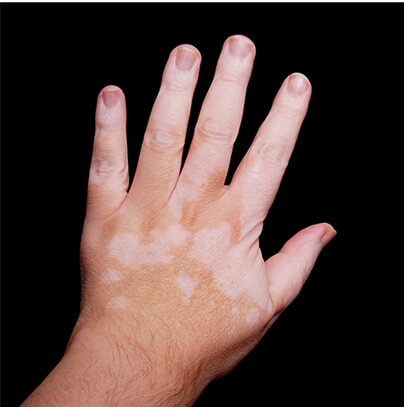Are you wondering about “What are your treatment options for vitiligo?” Before we jump into the various treatment options available, it is important to understand that the choice of treatment depends on diverse factors such as:
- Your age and medical history
- The extent of skin affected, the severity of your condition, and the location as well as size of your patches
- The rate at which vitiligo is progressing
- How the disease affects your life psychologically and physically

5 TYPES OF VITILIGO TREATMENTS
| Pros |
|
cons |
– Can be effective in returning skin to original tone through skin grafting or tattooing
– Best for small areas of the body |
SURGERY

|
– The most expensive and riskiest option for treating vitiligo
– Not always effective
– Side effects include scars and skin infections |
– 50 to 75% of patients see positive results
– Best for legs, arms, back and face |
PUVA LIGHT THERAPY

|
– Possible side effects include skin burns, blisters and even skin cancer
– Patients need to receive treatment at least twice a week for a year
– Pricey and not always effective |
– Can be taken with drugs
– Can take 4 to 6 months and 45% of patience to see good results
– An affordable treatment option
– Available in many pharmacies |
TOPICAL TREATMENT

|
– Usually effective on the face only
– Not as effective on other body parts
– Side effects include dry skin or skin allergies |
– Using makeup to even skin tone is quick and easy
– Barely any side effects
– Best for children
– Carries little or no risk |
COSMETIC TREATMENT

|
– Does not actually treat vitiligo
– Only a temporary option as makeup washes off |
– The most affordable and safest treatment option for vitiligo
– No side effects or any risk
– Uses natural & holistic remedies
– Treat by eating healthy foods |
NATURAL TREATMENT

|
– May not always be effective as other options
– Requires changes to diet and lifestyle |
Based on these factors, three types of treatment options may be available to you: vitiligo treatment home remedies, medication and vitiligo treatment creams, and surgical options, or a combination of the three. That said, not all treatments work for everyone, and some may even cause unwanted side-effects.
Important:
It is critical that you speak to your doctor before self-prescribing or experimenting with the treatment options mentioned below.
Let’s take a deeper look at the treatment options available at your disposal:
A. Vitiligo Treatment and Vitiligo Home Remedies
These easy self-care tactics can help improve your skincare and appearance. These points also help improve the mental distress associated with the condition:
- Applying a strong sunscreen as often as possible – especially if you are stepping out
- Wearing clothing that prevents excessive skin exposure
- Avoiding tanning beds and sunlamps
- Concealing the affected skin with the right makeup and self-tanning products, if you want to.
- Using skin camouflages (longer-lasting waterproof creams under vitiligo treatment creams) that can blend with your vitiligo patches to match your natural skin tone, if you want to conceal it. However, vitiligo is becoming increasingly normalized, so there’s no need to feel pressured into hiding your condition
- Avoiding getting a tattoo as it damages your skin
- Communicating your feelings to loved ones and going to support groups in your area for people with vitiligo
There are also some vitiligo home treatments that can improve the condition of your skin. While they cannot cure vitiligo, they can treat dryness and rough patches that people with vitiligo often experience.
- Papaya is a good natural exfoliator and can smoothen your skin. Simply rub pieces of papaya on the affected area and wash it when dry.
- Consume foods that are high in zinc or consume Zinc supplements to speed up the healing process of the skin against vitiligo.
- You can also include vitamin C-rich foods in your diet, such as orange, lemons, grapefruits, strawberries, kiwi, bell peppers, and broccoli.
B. Ultraviolet Therapy
Narrow-Band Ultraviolet B (UVB) Therapy
Historically, it has been seen that light-based therapies such as ultraviolet therapy can slow down the progression of active vitiligo and help restore the skin colour and even out the skin tone.
Narrow-Band Ultraviolet B (UVB) therapy is considered a healthy alternative to traditional PUVA therapy as it is a more focused type of light therapy and comes with fewer side effects.
This treatment option, when used along with corticosteroids or calcineurin inhibitors, can be effective. Possible side effects include redness, itching, and burning; though these may clear up within a few hours post-treatment.
Note
These treatments can have serious side-effects so please consult your doctor to understand the next steps.
Psoralen and Ultraviolet A (PUVA) Therapy
In this type of therapy, you’re prescribed a topical psoralen as a pill or a cream. The doctor then examines your skin by exposing it to the ultraviolet A light (a technique called PUVA) to restore the skin colour. The skin turns pink after each exposure, eventually turning to a normal hue as the treatment goes on.
If vitiligo affects more than 20% of the body, this treatment may be given two to three times a week. Also note that in some cases, the psoralen can be taken orally instead of topically.
Self-care tips include reducing sun exposure and wearing protective sunglasses. Side effects include sunburn, nausea, itching, and hyper-pigmentation.
Depigmentation: Removing the Remaining Color
This therapy is permanent in nature and is applicable for people whose vitiligo may be widespread (more than 50% of the body). It can also be used for people for whom other treatments haven’t worked.
In this, a depigmenting agent is applied to unaffected areas of skin to lighten the skin colour and allow a seamless blend with the discoloured areas. Side effects include inflammation, redness, swelling, itching, dry skin, and increased sensitivity to sunlight.
C. Medications and Creams
In order to prevent vitiligo relapse, your doctor may recommend medication that can be applied to the skin as maintenance therapy. These include corticosteroid creams that might help return the skin colour – especially in the early stages of the disease or help slow down the growth.
Topical corticosteroids are helpful for cases with less than 10% of vitiligo coverage and when the face is not affected. These topical treatments may be too harsh for vitiligo treatment for face. For people with a case of severe vitiligo, corticosteroid pills and injections might be an effective option.
Like any treatment, it may take time to show the desired results. Plus, it might cause side effects such as skin thinning, shrinkage, excess hair growth, skin irritation, or streaks or lines on your skin.
Note
No medicines or treatments can stop the loss of pigment cells, however, some medicines when used in combination with light therapy can help restore the skin tone.
D. Surgery
For people who don’t experience any success with light therapy and medications, surgery is the next best option. Generally, your doctor or general surgeon will recommend surgery if you have had no new or worsening white patches in the last 12 months and if your vitiligo wasn’t caused by sun damage.
The following are the different types of surgical treatments that can help even out skin tone by restoring colour. However, you should consider vitiligo surgery cost before deciding to go ahead with this option.:
- Skin grafting: Useful for people with small patches of vitiligo. Here, the doctor transfers small sections of healthy, pigmented skin to the affected areas. Possible risks include infection, scarring, spotty colour, and permanent discolouration.
- Blister grafting: In this procedure, the doctor creates blisters on your pigmented skin and then transplants the tops of the blisters to discoloured skin. Scarring, a cobblestone appearance, and failure to recolour are some possible risks.
- Micropigmentation: This is a safe, effective, and cosmetically acceptable option for vitiligo of lateral lower lip. It provides immediate results. In this, your doctor will tattoo pigment into your skin to match your skin’s colour.
Summary:
– Treatment for vitiligo is not about stopping its spread. That said, the treatment options available can help reduce the appearance of the white patches and even out the skin tone.
– Depending on the severity of vitiligo, you can go for surgical, home-based, or medication treatment for segmental vitiligo.
Talk to top dermatologist at MFine and learn how to self-manage and treat Vitiligo!
 Gynecologist
Gynecologist General Physician
General Physician Orthopedician
Orthopedician Dietitian
Dietitian Pediatrician
Pediatrician Dermatologist
Dermatologist Psychiatrist
Psychiatrist Andrologist
Andrologist Diabetologist
Diabetologist Urologist
Urologist Gastroenterologist
Gastroenterologist General Surgeon
General Surgeon Endocrinologist
Endocrinologist Dentist
Dentist Cardiologist
Cardiologist Pulmonologist
Pulmonologist Fertility Specialist
Fertility Specialist Oncologist
Oncologist Neurosurgeon
Neurosurgeon Nephrologist
Nephrologist Neurologist
Neurologist Sports Medicine
Sports Medicine Cosmetologist
Cosmetologist

















